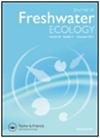Spawning schedule of the imperiled Bigeye Chub (Hybopsis amblops) in Illinois
IF 1.3
4区 环境科学与生态学
Q3 ECOLOGY
引用次数: 0
Abstract
Abstract The Bigeye Chub (Hybopsis amblops) once inhabited streams and rivers in eastern and southeastern Illinois and was thought to be extirpated in the state by the 1970s. However, it was rediscovered in the 1990s from the Little Vermilion River. Today, H. amblops has become widespread and locally abundant in streams of the Wabash River drainage. Currently, little is known about the spawning and reproductive ecology of H. amblops. We conducted a study in the Salt Fork Vermilion River to determine the spawning schedule and microhabitats of H. amblops. Based upon near-weekly samples in May and June in 2019 and 2021, we determined H. amblops spawns in moderate water velocity over sandy gravel substrates when water temperatures are between 18–22 °C. Understanding such ecological traits is necessary for the continued success of H. amblops throughout its range.伊利诺伊州濒临灭绝的大眼Chub(Hybopsis ambrops)的产卵时间表
摘要大眼Chub(Hybopsis amblops)曾居住在伊利诺伊州东部和东南部的溪流和河流中,被认为在20世纪70年代在该州灭绝。然而,它在20世纪90年代从小朱河被重新发现。如今,H.amblops已经在Wabash河流域的溪流中广泛分布,并在当地大量存在。目前,人们对游龙的产卵和繁殖生态知之甚少。我们在Salt Fork Vermilion河进行了一项研究,以确定H.amblops的产卵时间表和微栖息地。根据2019年和2021年5月和6月的近周样本,我们确定当水温在18-22之间时,H.amblops在砂砾基底上以中等的水流速度繁殖 °C。了解这些生态特征对于H.amblops在其整个范围内的持续成功是必要的。
本文章由计算机程序翻译,如有差异,请以英文原文为准。
求助全文
约1分钟内获得全文
求助全文
来源期刊
CiteScore
2.20
自引率
7.70%
发文量
34
审稿时长
3 months
期刊介绍:
The Journal of Freshwater Ecology, published since 1981, is an open access peer-reviewed journal for the field of aquatic ecology of freshwater systems that is aimed at an international audience of researchers and professionals. Its coverage reflects the wide diversity of ecological subdisciplines and topics, including but not limited to physiological, population, community, and ecosystem ecology as well as biogeochemistry and ecohydrology of all types of freshwater systems including lentic, lotic, hyporheic and wetland systems. Studies that improve our understanding of anthropogenic impacts and changes to freshwater systems are also appropriate.

 求助内容:
求助内容: 应助结果提醒方式:
应助结果提醒方式:


